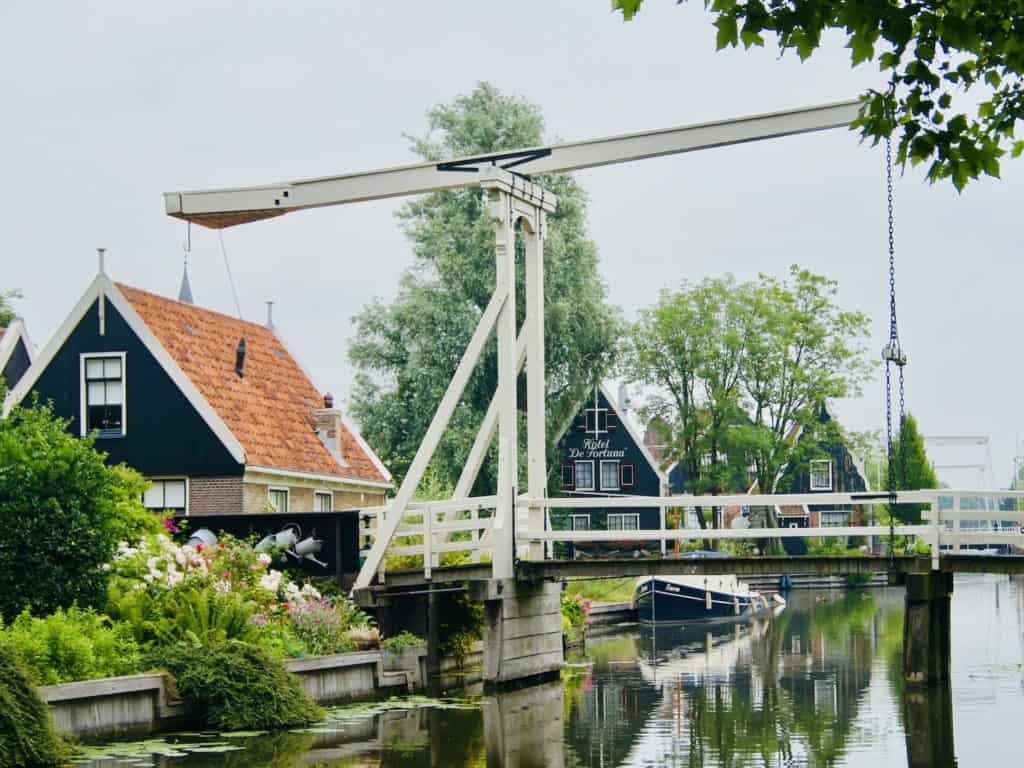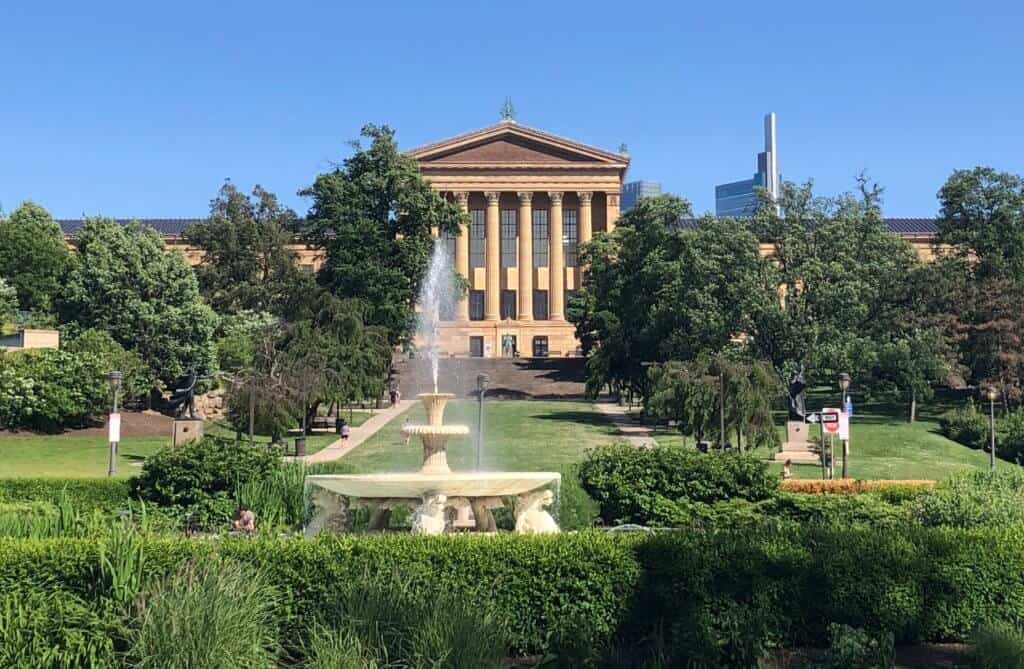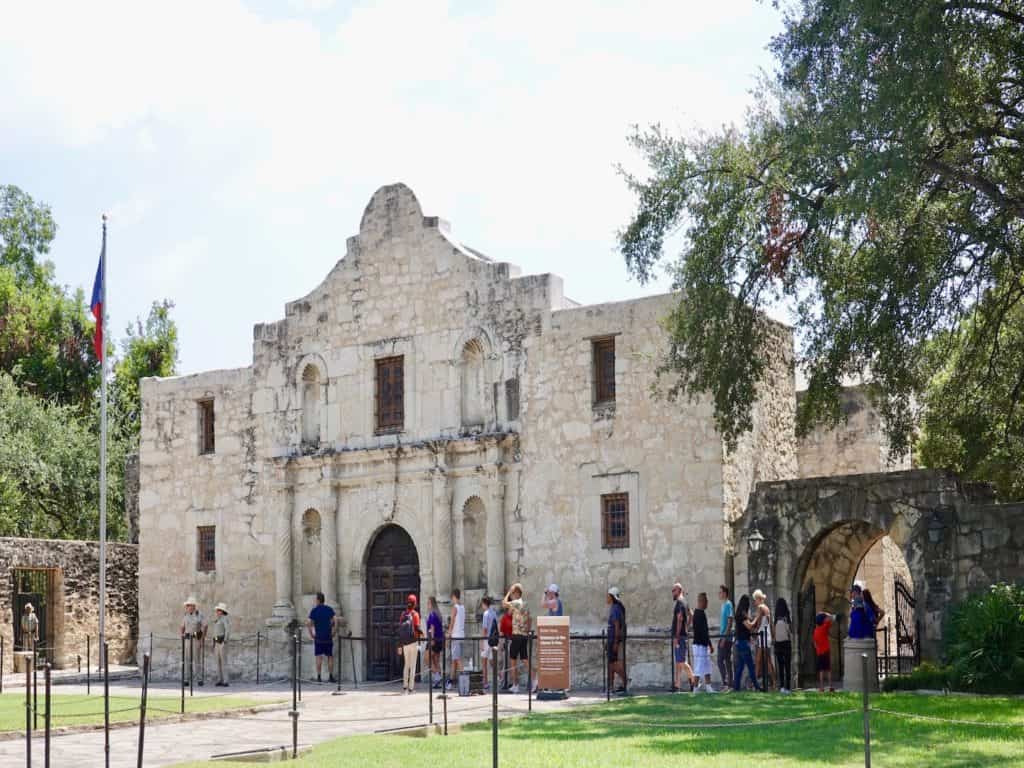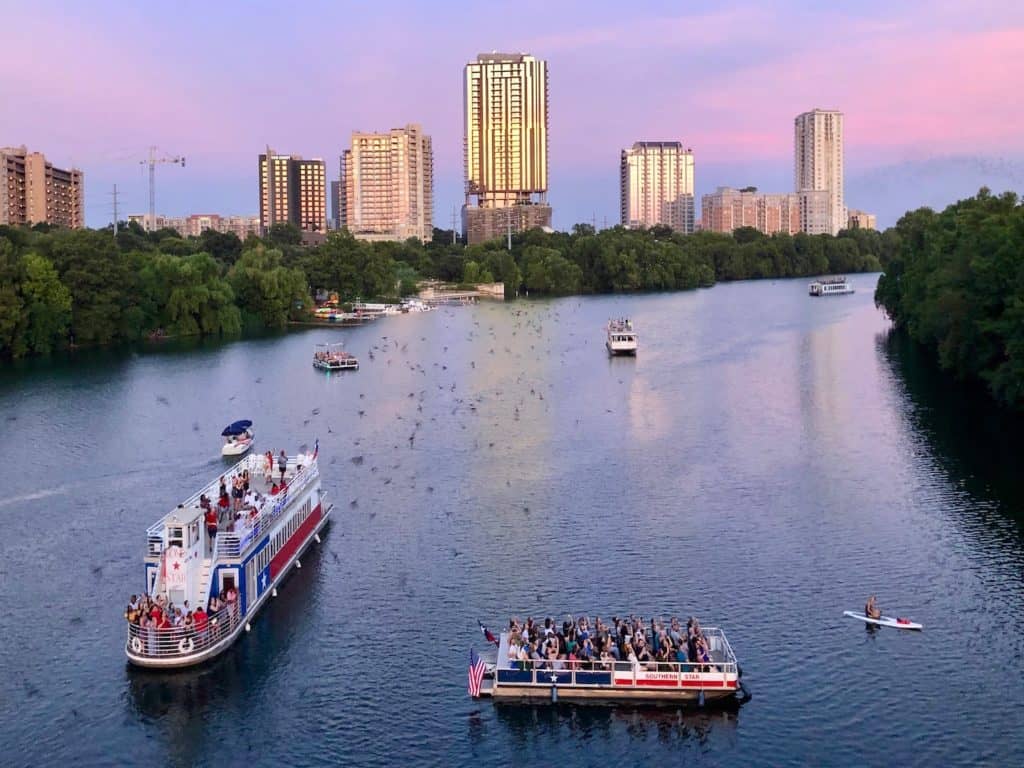Walk in the footsteps of history on the same ground trodden by the Continental Army over two centuries ago. Located along the Pennsylvania side of the Delaware River, Washington Crossing Historical Park is the area where General George Washington’s Continental Army encamped for three weeks in December 1776. From here, he and his army crossed the Delaware River on Christmas Day 1776 to surprise the Hessian soldiers (fighting for the British) who were wintering in Trenton, NJ. That battle helped turn the tide of the American Revolution. My husband and I visited Washington Crossing Historic Park and were impressed with the history represented here as well as the various recreational options.
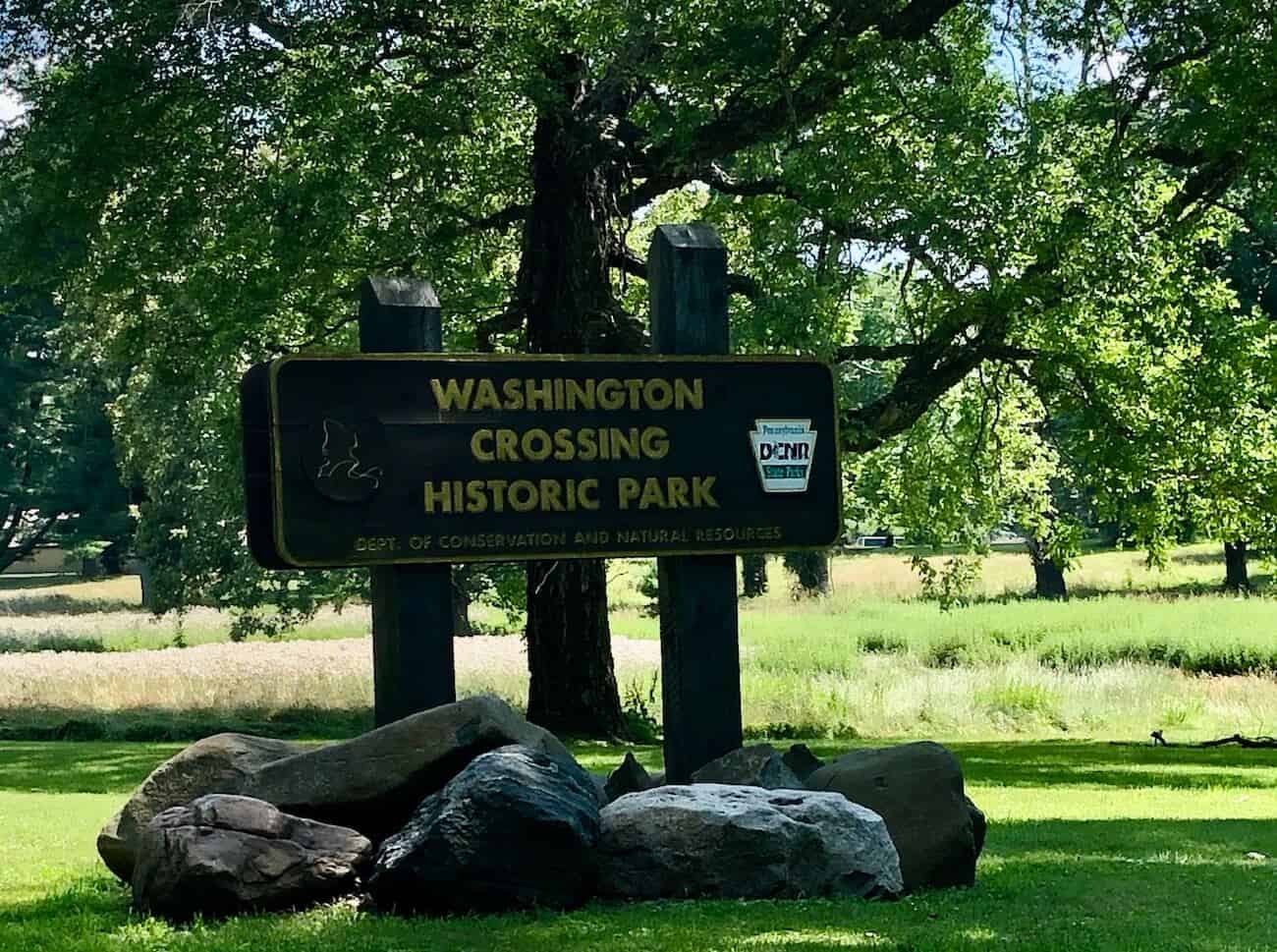
Accessibility
Washington’s Crossing Historic Park visitor’s center and the outdoor part of the guided tour of the Historic Village are wheelchair accessible.
Admission
Enjoying the grounds of Washington’s Crossing Historic Park is free. There are fees for the guided tours (that are offered Wednesday through Sunday at certain times of the day):
- Bowman’s Tower guided tour – $7
- Historic Village guided tour – $7
- Thompson-Neely Home & Grist Mill guided tour – $7
- Combined Ticket for all 3 sites – $15 ($6 savings over tickets to individual sites)
Check online for updated information on tickets and tours.
What You’ll Find at Washington Crossing Historic Park
The park is divided into two sections: the Upper section has the first three sites listed below. Three miles south on Route 32 is the Lower section which has the remaining sites.
Bowman’s Tower
This 125-foot tower was built to commemorate the American Revolution. Some may assume that this served as a lookout during the American Revolution. It didn’t. Actually, it was built in 1930 to increase recreational options in the area. Even though it isn’t a historic site, it’s worth a visit. You can walk up — or take the elevator most of the way and walk the last few (less than 30) steps to the apex. From the top, you’ll have endless views — the Delaware River and New Jersey to the east and nearby towns to the west.
When we visited Bowman’s Tower, we could see the Thompson-Neely Farmstead & Grist Mill and the American flag at the Soldiers’ Graves to the east — two nearby sites that I recommend you visit and that are detailed in the coming paragraphs.
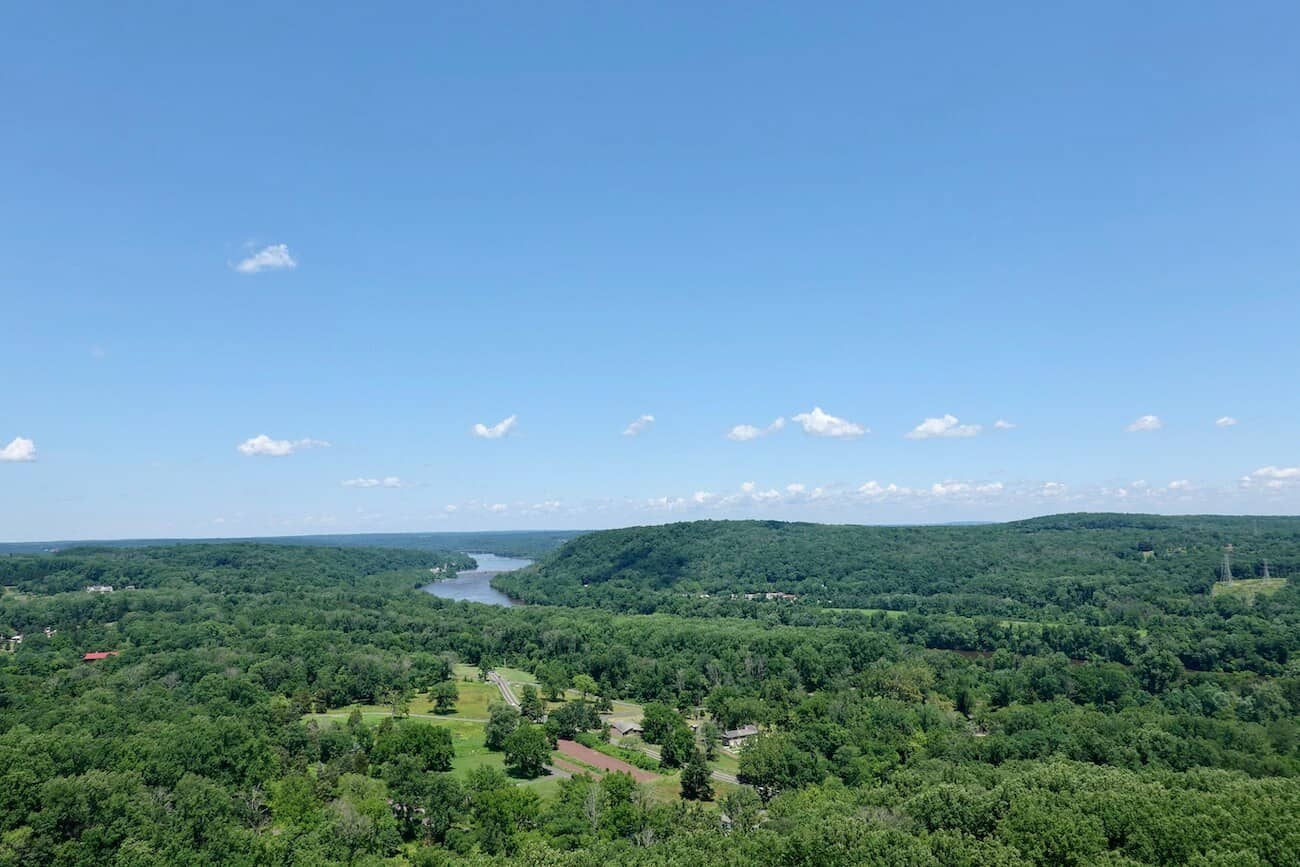
Thompson-Neely Farmstead & Grist Mill
This property is historically significant because it became an encampment area used by some of General George Washington’s Continental Army in December 1776. The 500-acre property was close to several river ferry crossings (to and from New Jersey) which made it an ideal spot for the weary troops to rest and wait for direction from General Washington.
Lieutenant James Monroe (later the 5th U.S. president) and Captain William Washington (George Washington’s cousin) were part of that encampment here.
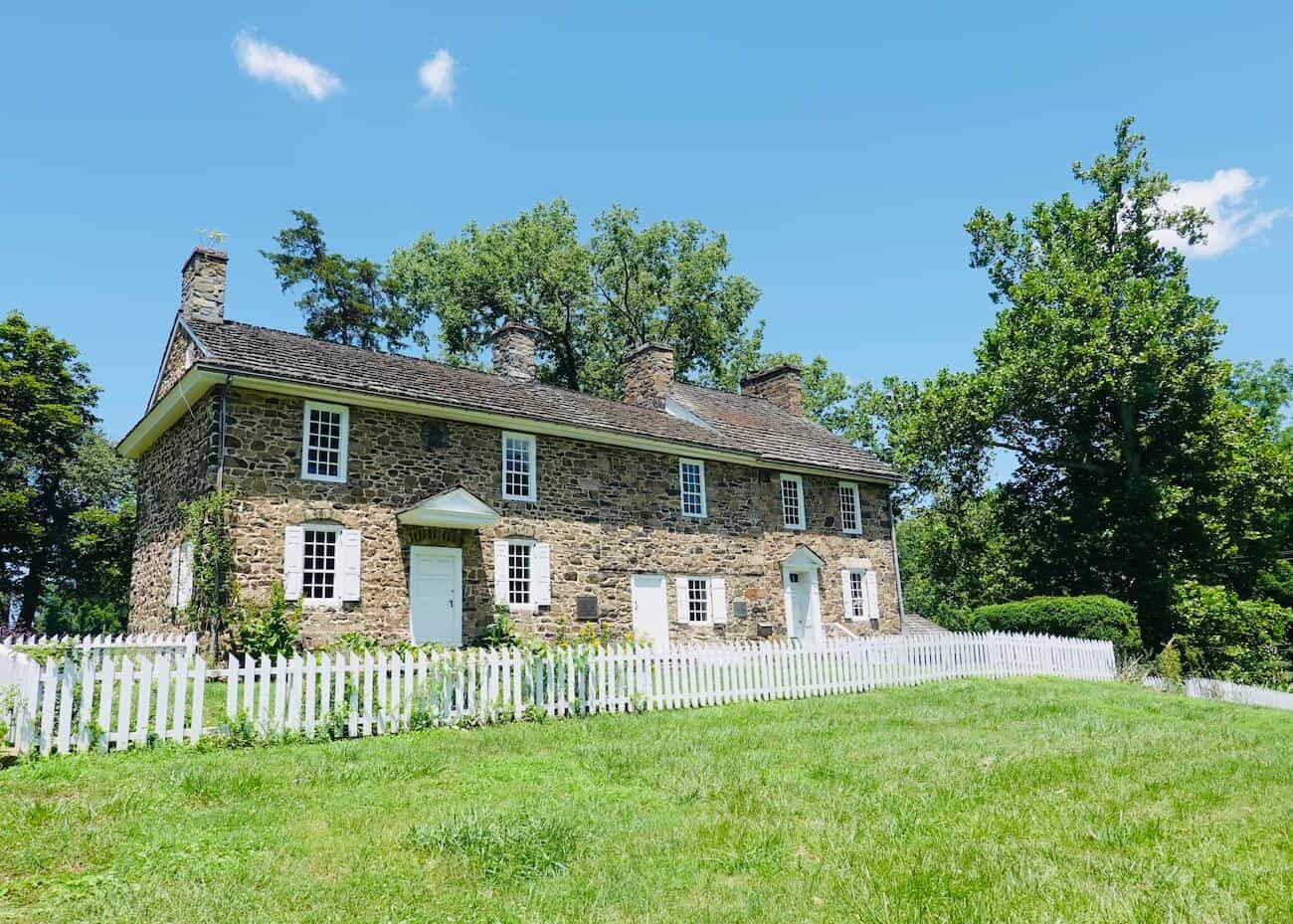
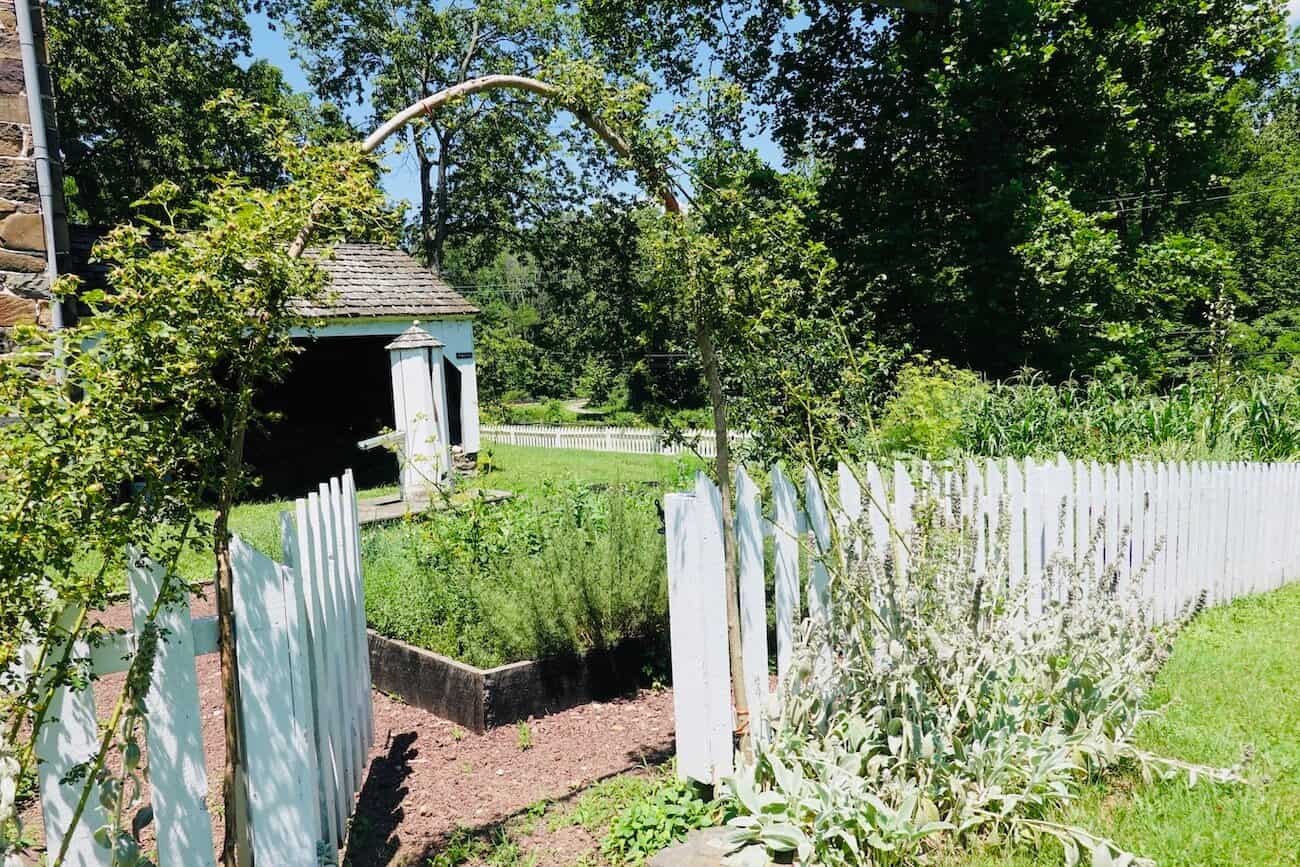
Healing the Sick
The house was used to house and treat sick American soldiers. Army officers were also housed in the home. Soldiers used the barn and other outbuildings for protection from the elements.
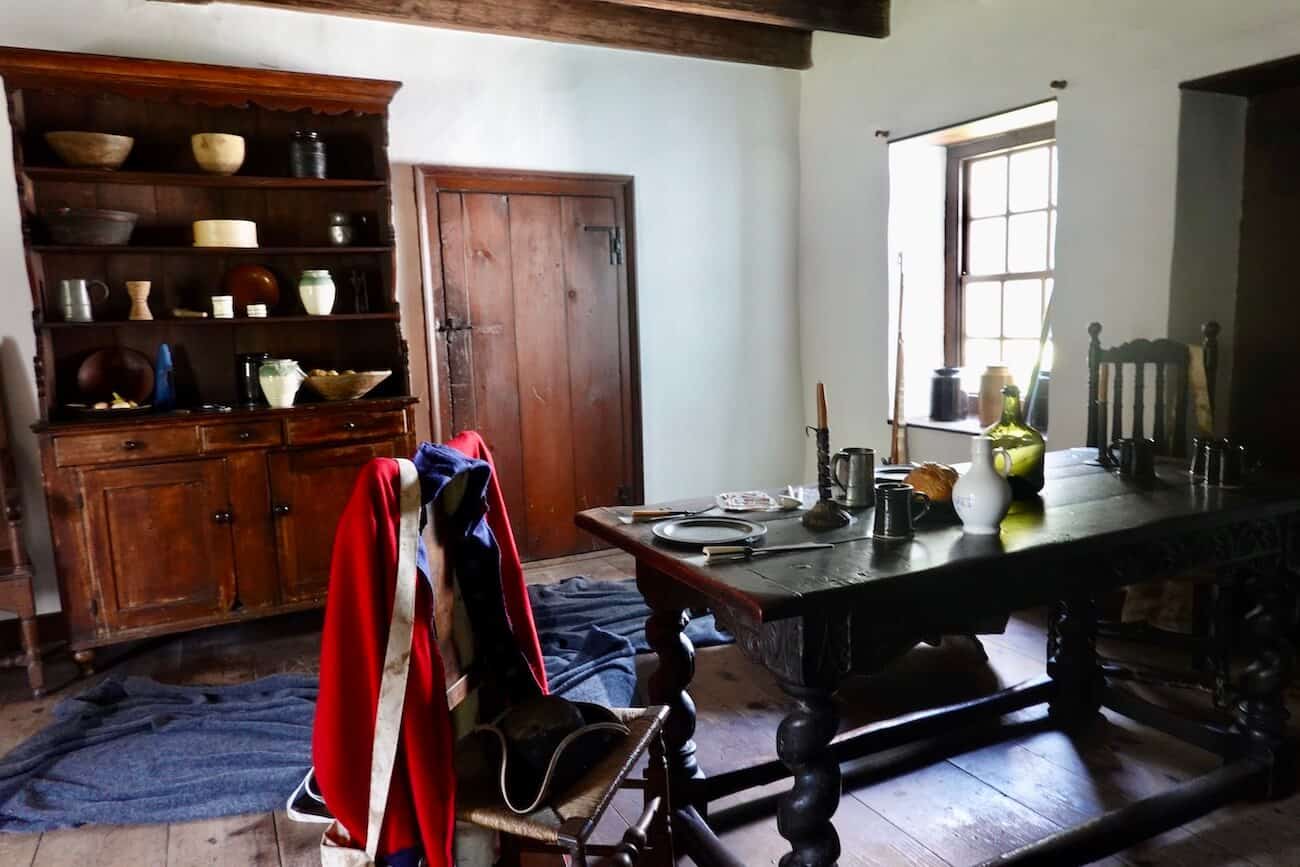
Once a working farm with a grist mill, the property was home for Robert and Hannah Thompson and their children. The Thompsons expanded the home’s original footprint (which dates back to the early 1700s). After their daughter Elizabeth married William Neely, the newlywed couple enlarged the house on the other side of the original dwelling. The kitchen was the one room common to both wings of the house. The guided tour includes a visit inside the home and the grist mill, a short walk away.
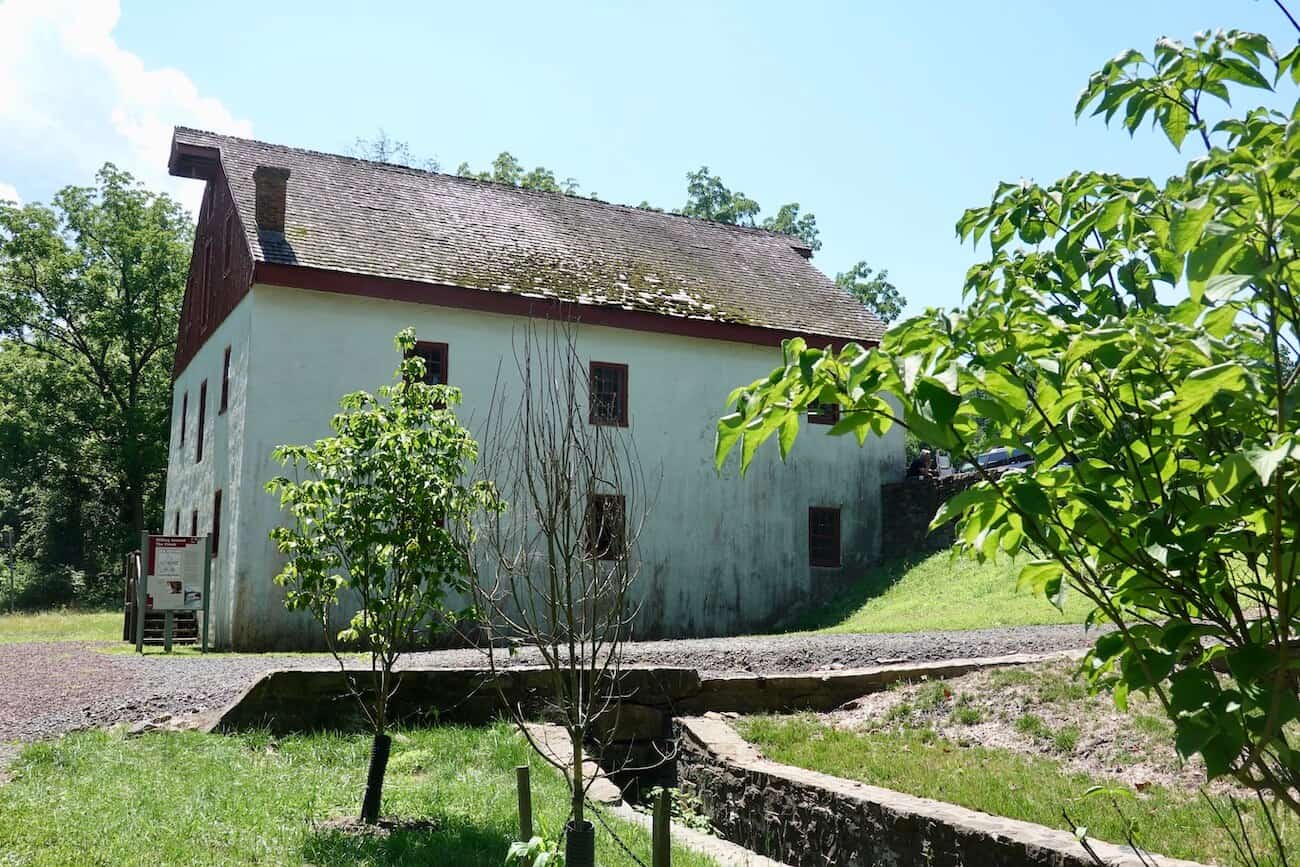
Grist Mill
The grist mill was used to grind wheat and corn into flour — an essential staple of diets at the time. The tour of the grist mill helps you understand the technology used in the milling process during the 18th century. You’ll learn about the grinding process to make the flour, how a large water wheel powered that process, and the sifting process that produced various consistencies of flour from an ultra-fine texture to the more coarse whole-grain/bran texture. You’ll also come away with an appreciation for the hard work of maintaining the grist mill. This is an operating grist mill for demonstration purposes.
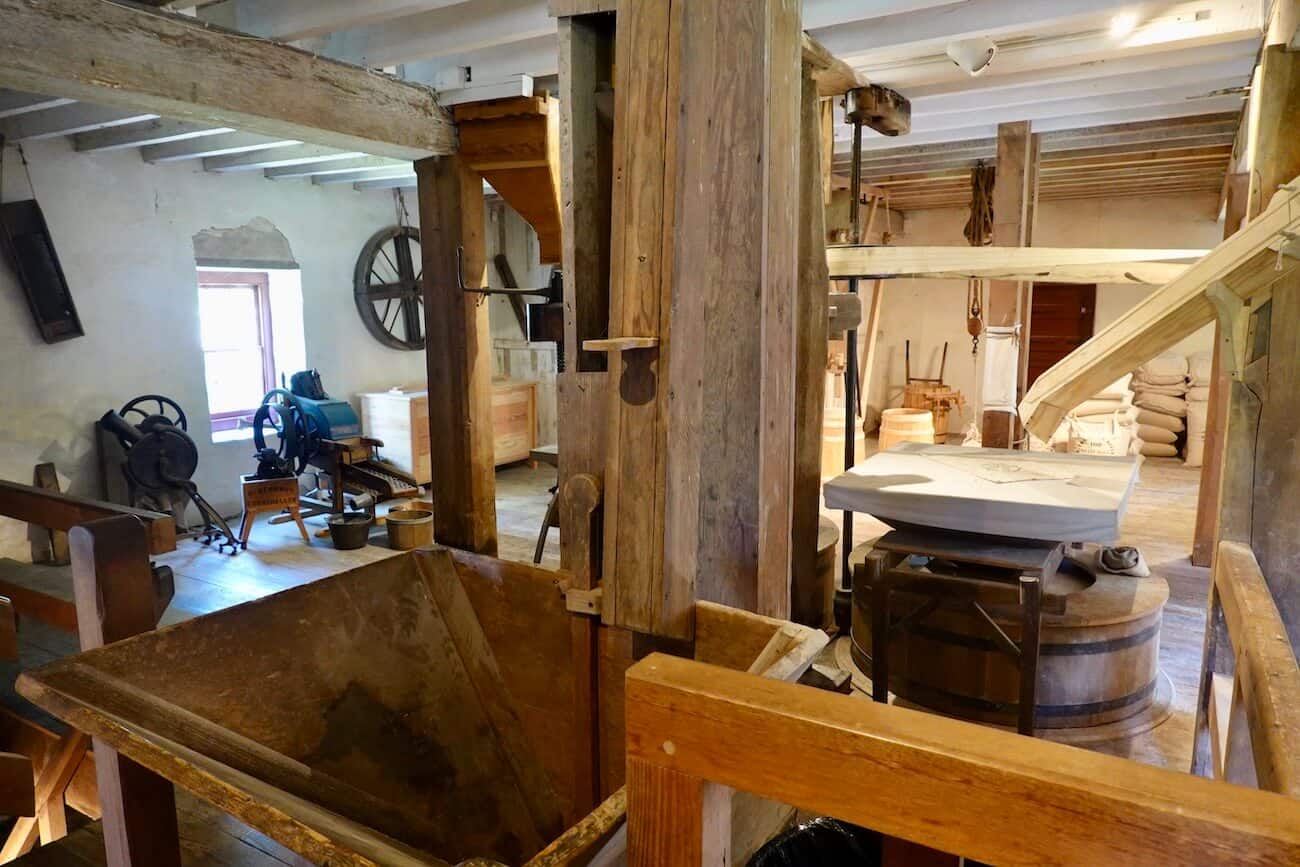
Soldiers’ Graves
This graveyard is the final resting place of dozens of unknown soldiers who died while the Continental Army camped on this land in December 1776. The men died from disease or from exposure — none of the deaths were from the battle itself. Only one man buried here is known by his name: Captain James Moore, who died at age 24. Along the flagpole’s base are inscriptions of the 13 original colonies and the years their legislators ratified the U.S. Constitution — making them states.
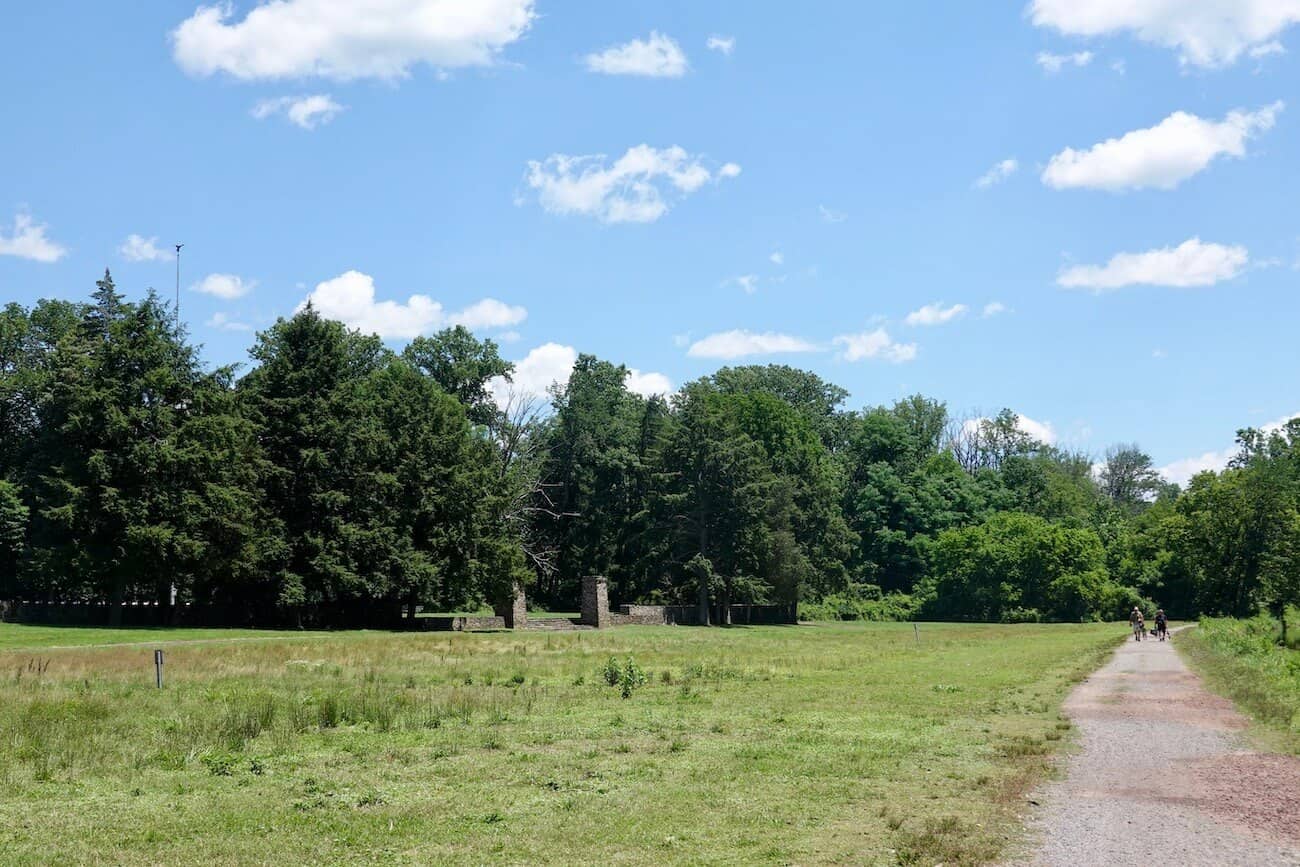
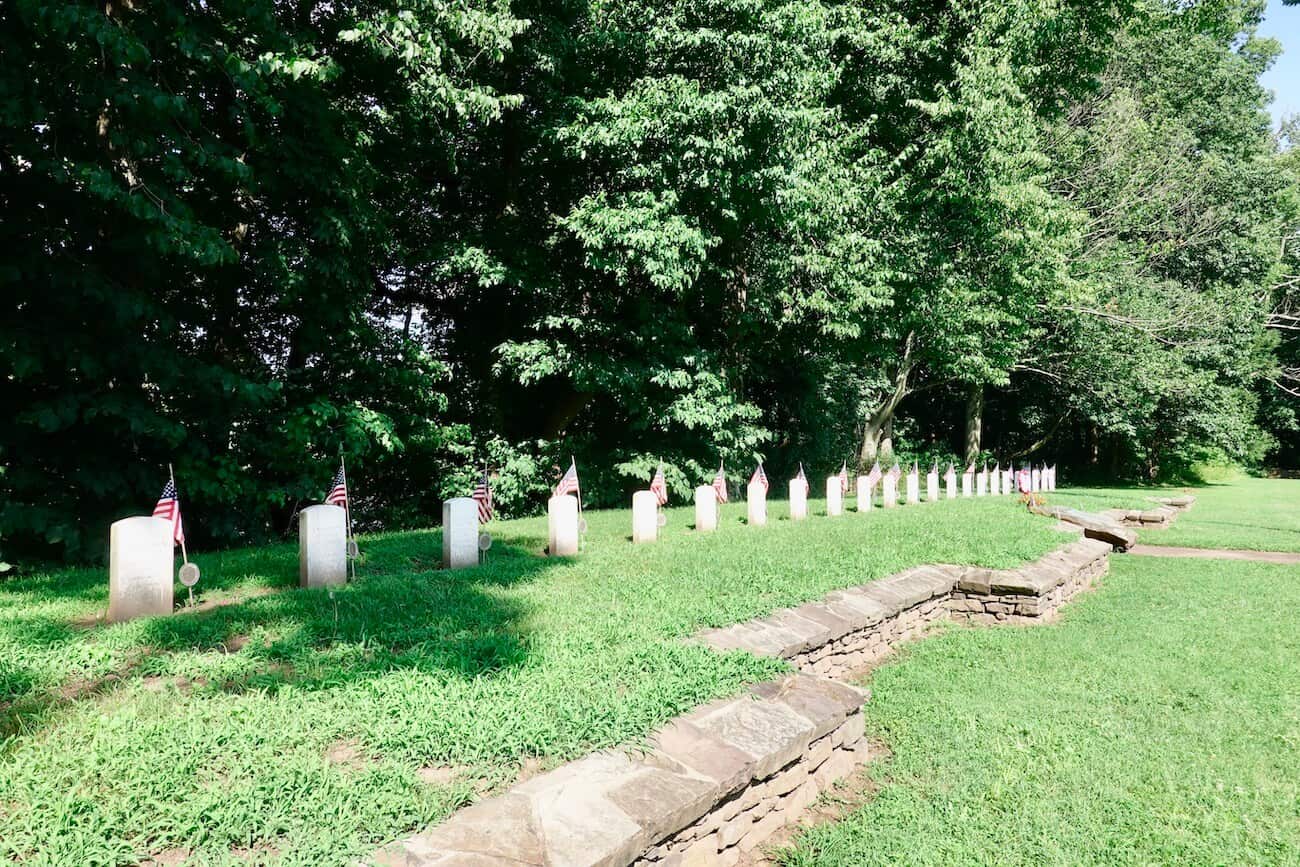
Three miles down Route 32, you’ll find the Lower section of the park. Here are Washington’s Crossing Historic Park Visitor’s Center, a couple of buildings that stood when George Washington’s army was stationed in the area, some buildings that date to the 19th century along with a park with plenty of open space, picnic tables, and soccer fields. (The 60-mile Delaware Canal State Park towpath has a 5-mile section that connects the Upper and Lower sections of this park if you’re walking or biking.)
Visitor Center
Here you’ll find plenty of information (including correspondence in late 1776 regarding the coming skirmish with the British across the Delaware River). Also housed here is the enormous iconic and idealistic painting showing George Washington crossing the Delaware River with some of his troops. (It’s idealistic because it’s highly doubtful that Washington would be standing in the boat while crossing the icy river in late December of 1776.) It’s impressive, nonetheless.
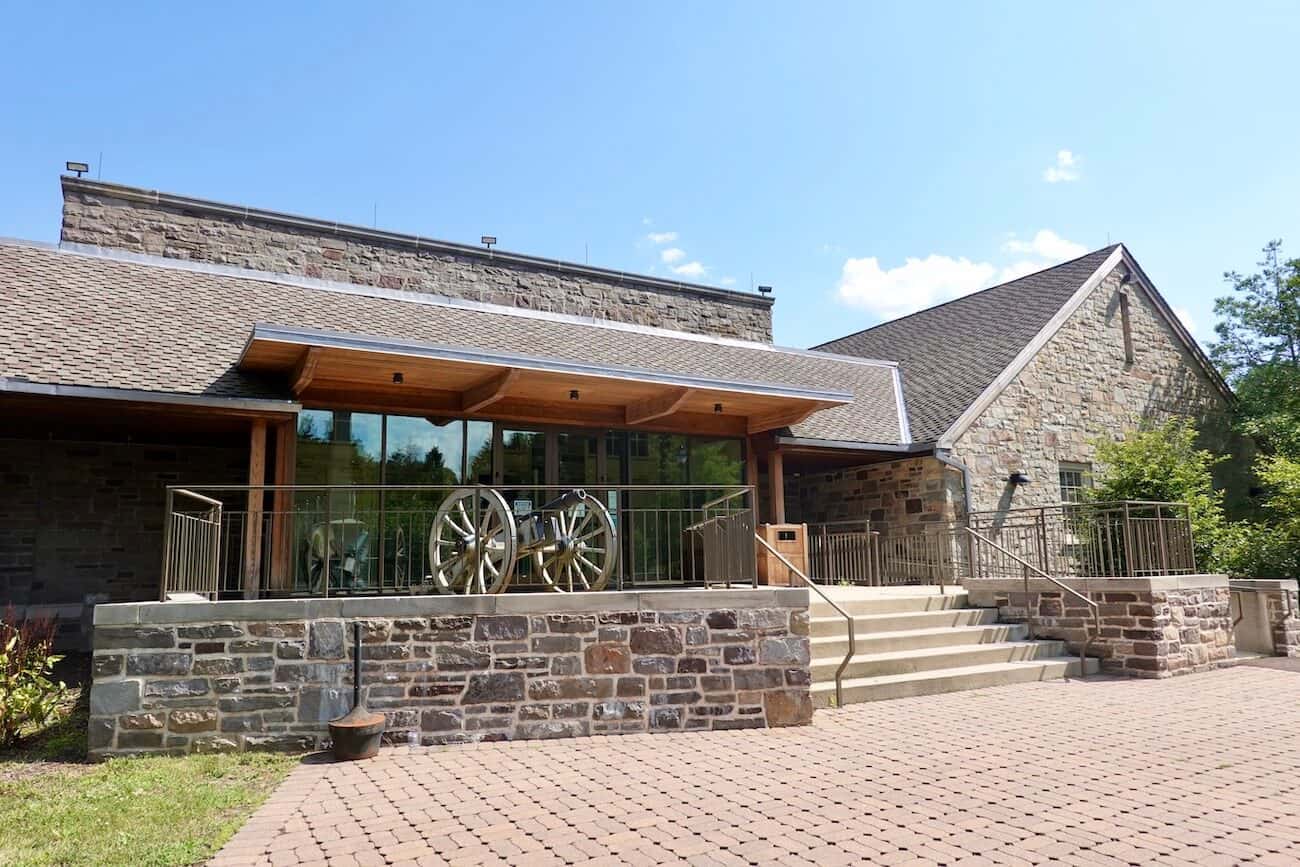
Durham Boat House
Replicas of the Durham boats used to carry soldiers across the Delaware River are found here. Durham boats were used to haul heavy loads and they were the type of boats used by General George Washington when he crossed the Delaware River on December 25, 1776, with his troops. You can walk inside this building to view the boats up close on the guided tour.
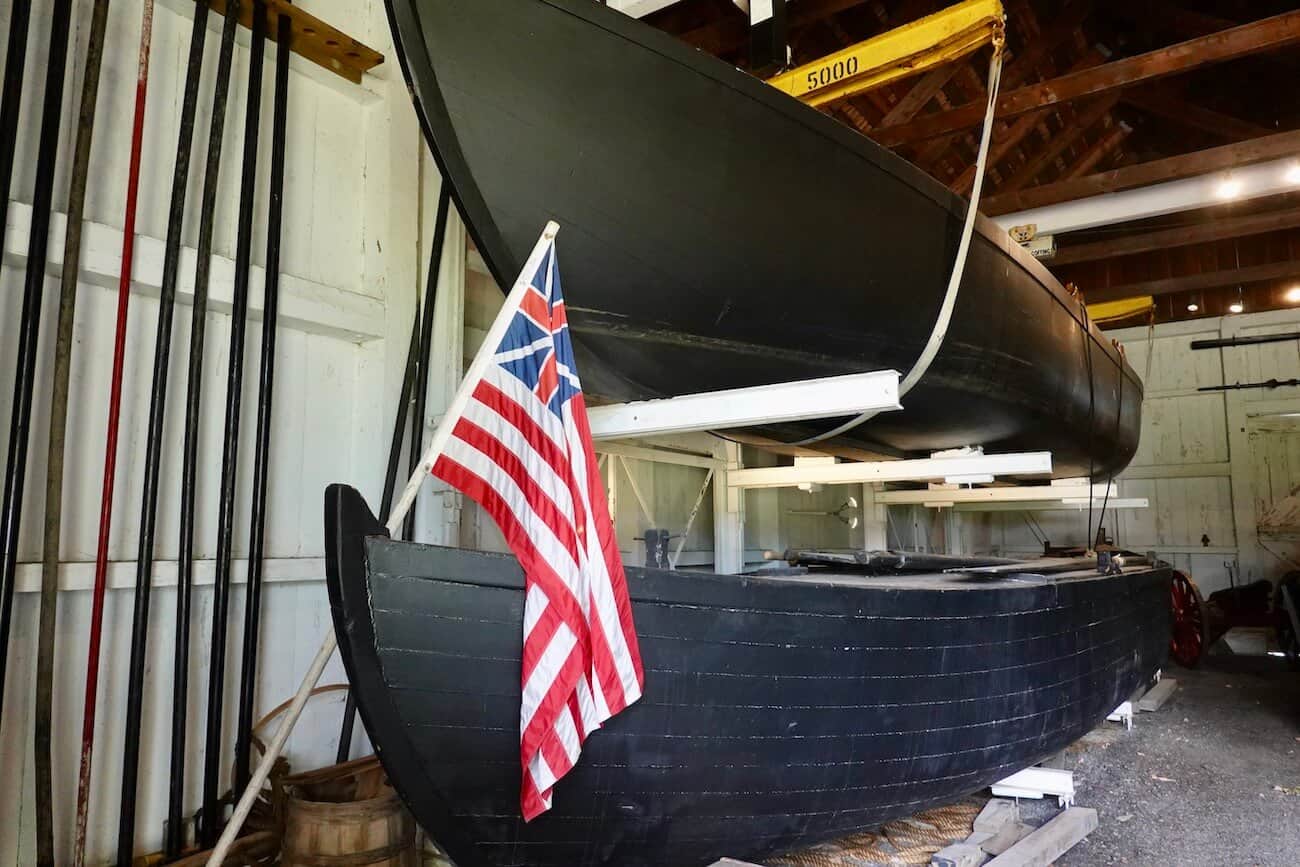
Frye House
The Taylor family built this house in the early 19th century to attract tradesmen to the area. There is a recreated blacksmith shop behind the house because a blacksmith originally inhabited this home.
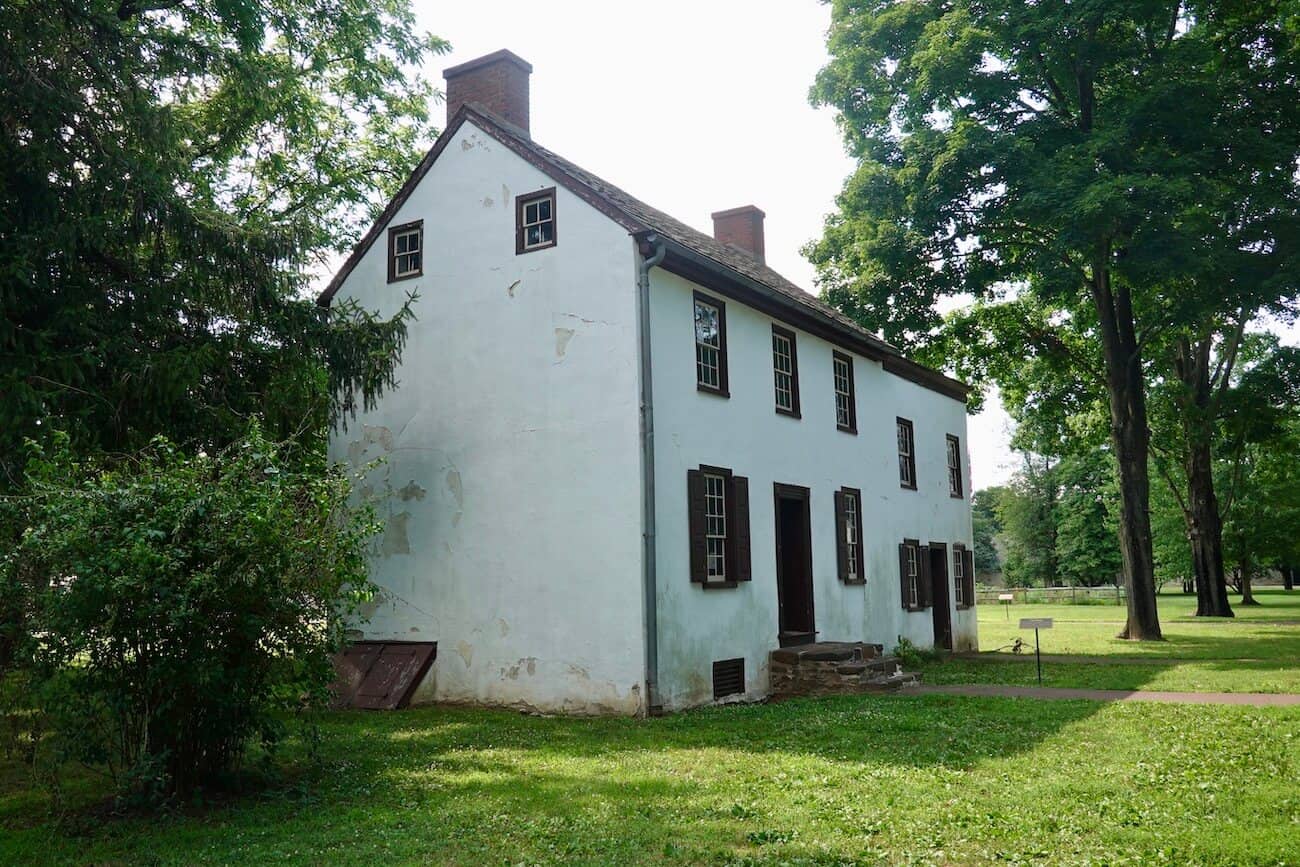
Hibbs House
This home was built in the early 19th century and was used as a boarding house. Behind the house is a kitchen garden (with vegetables and herbs for cooking) and a pleasure garden (with flowers).
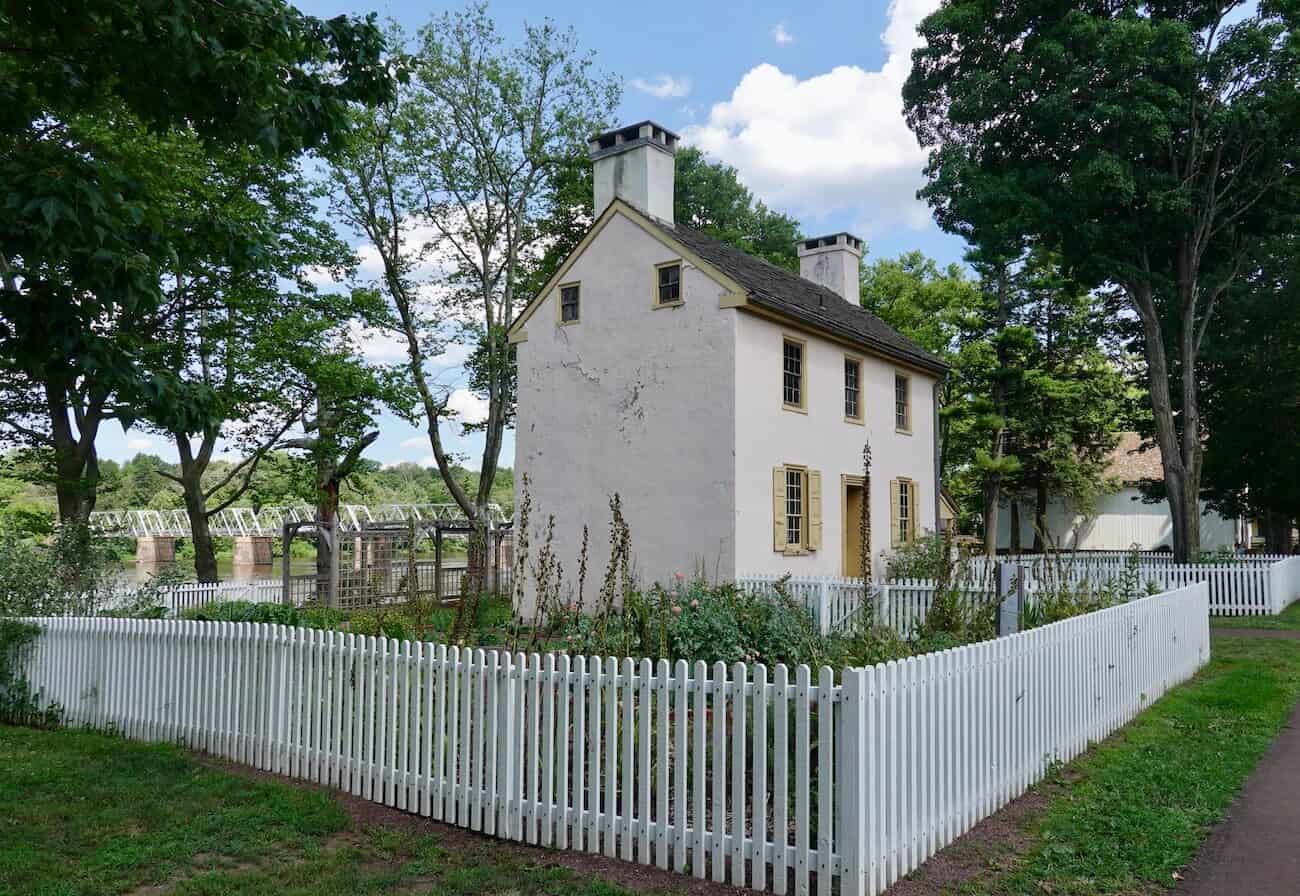
Mahlon K. Taylor House
This home belonged to the Taylor family and was built in the early 19th century. This area became known as Taylorsville due to the prominence of the Taylor family.
McConkey’s Ferry Inn
Samuel McConkey owned this inn and tavern. During the Revolutionary War, it was also used as a guardhouse. It is believed that George Washington and his top officers ate here on Christmas Eve before crossing the Delaware River the next day. If on the guided tour, you will tour this building.
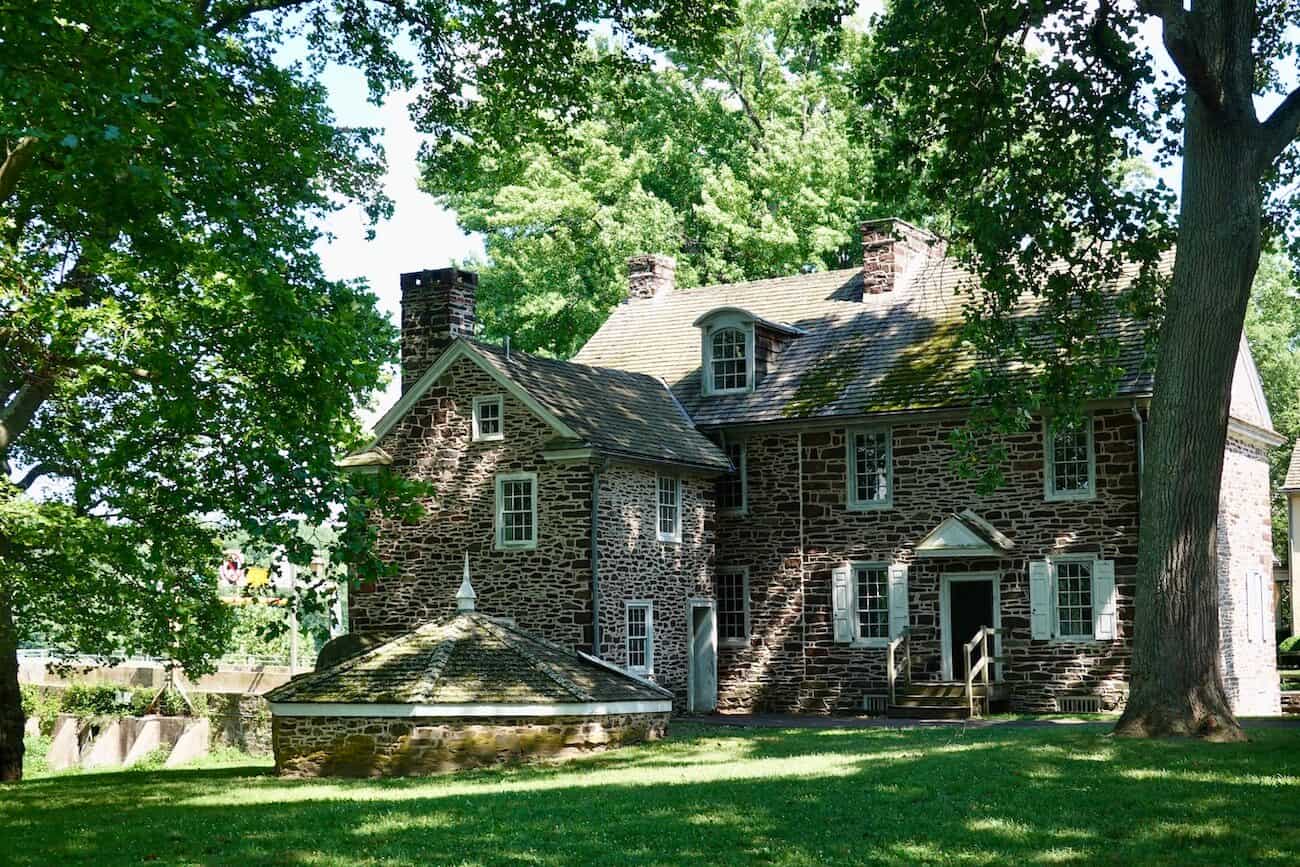
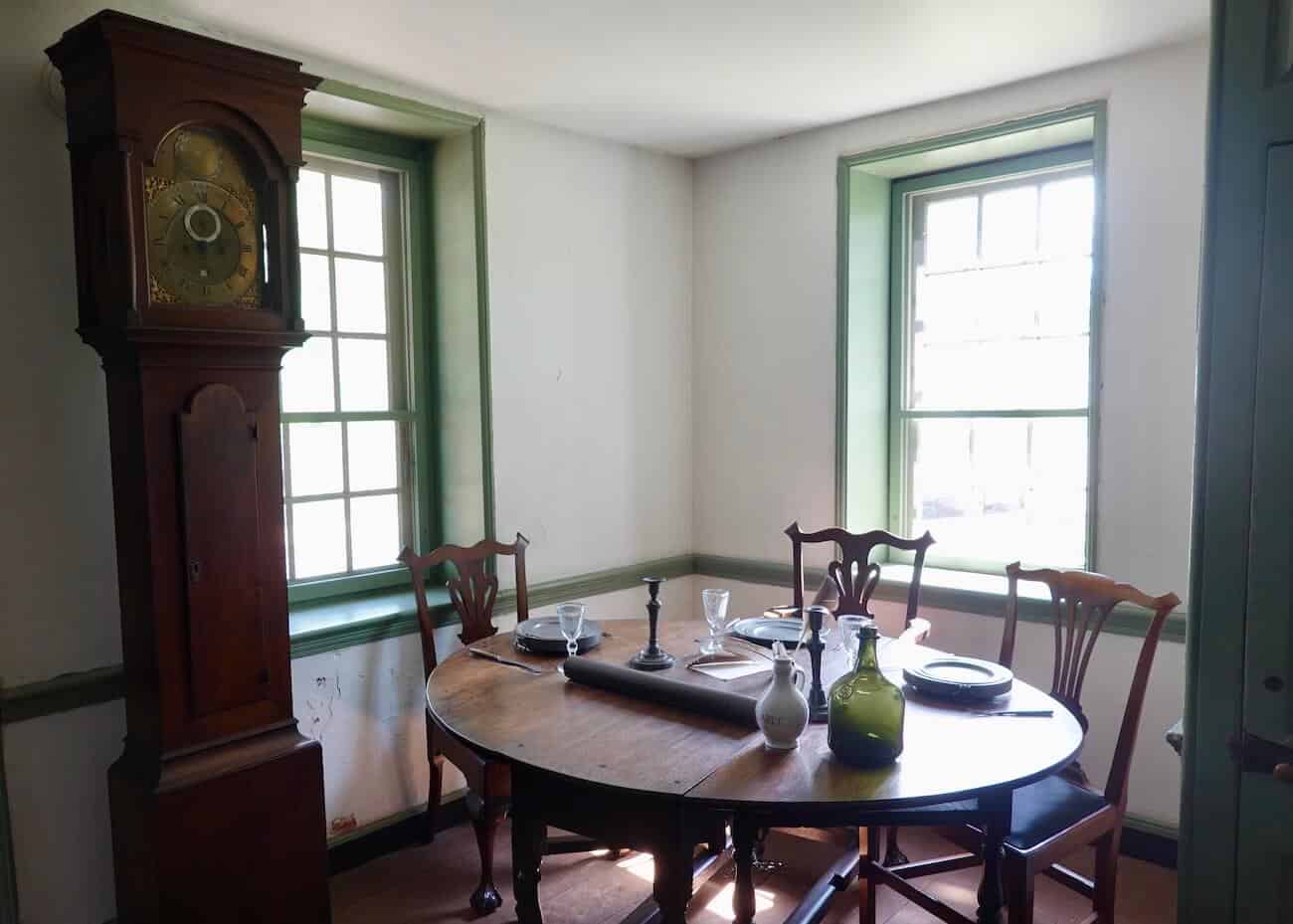
Taylorsville Store
From around 1828, this store was owned by Mahlon Taylor, who also served as postmaster for about 40 years.
Map
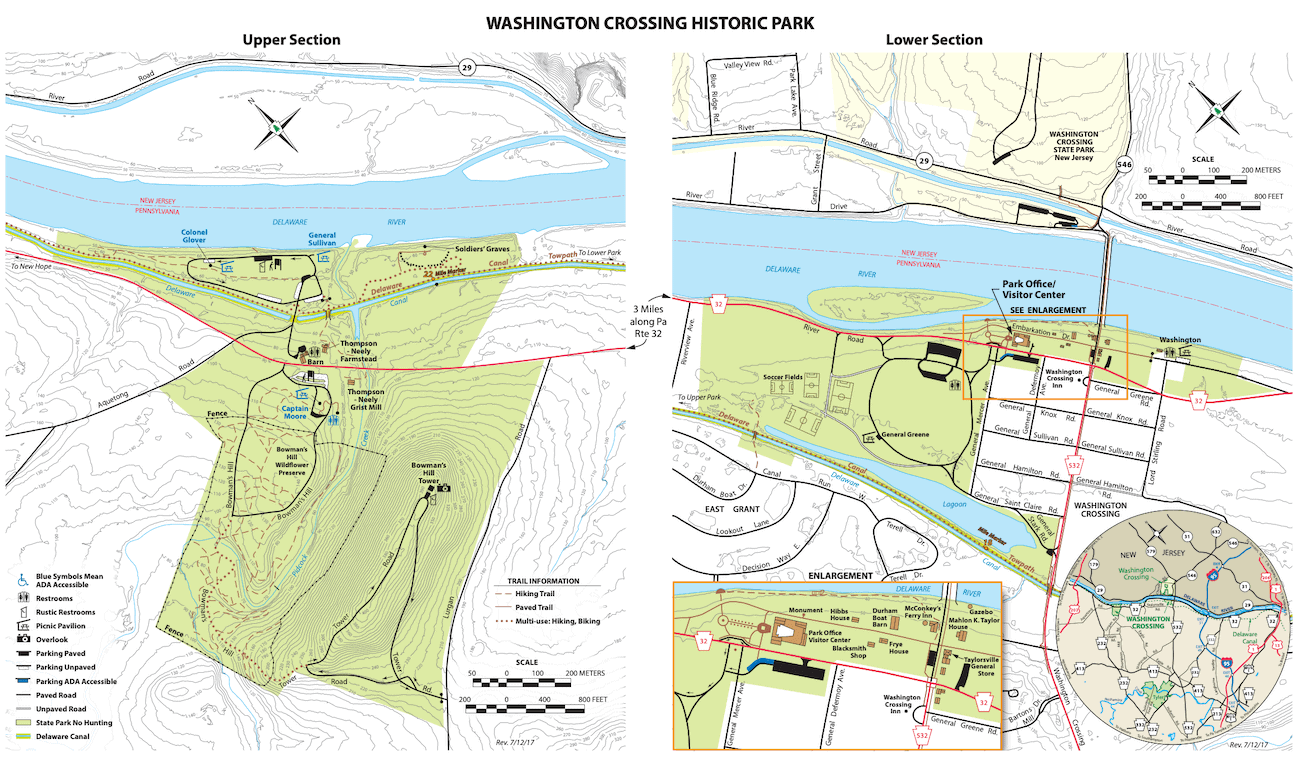
Tips for Your Visit
- Buy your tickets online.
- Watch a video on YouTube before visiting to gain an overview of the history represented here. (This is a tip from the park’s website.)
- Check out the park’s calendar of events. One unique annual program is the re-enactment of the crossing on December 25.
- Decide how you want to enjoy this park. Guided tours are offered at certain times of the day, Wednesday through Sunday. If time is not an issue and you want to enjoy the nearby grounds, consider strolling or biking along the towpath by the Thompson-Neely Homestead or relaxing on the expansive lawn (bring a chair) overlooking the Delaware River by the visitor’s center.
- Bring your own food and drink. Don’t forget to bring water!
- There are picnic tables near the Thompson-Neely house in the Upper section and across the road from the visitor’s center in the Lower section.
- Carry in, carry out. Plan to take your trash home with you.
- If you need a restroom, some are at the Thompson-Neely Farmstead and the visitor’s center.
- Do NOT feed or otherwise disturb any wildlife.
- Leashed pets are allowed on the park grounds.
Historic Perspective of this Park
In June 1775, George Washington became Commander-in-Chief of the Continental Army and proceeded to New England to take command of the forces facing off against the British in Boston. In March 1776, Washington’s artillery placement at strategic locations forced the British to abandon Boston. From here, Washington decided that the most important location in the colonies to defend was the New York City region. He promptly moved his army to Long Island. The British responded by invading Long Island at the end of August 1776.
Continental Army Woes
Every battle that followed through Long Island, Manhattan, and over into New Jersey was a decisive defeat for Washington and his army. By December 1776, the Continental Army had shrunk considerably — mostly from turnover and expiring enlistments. Morale was rock bottom. The Continental Congress had not appropriated funds for winter clothing for the troops. The men hadn’t been paid for months. Many of the soldiers’ enlistments would expire on January 1, 1777. Things were looking dire.
In a strange way, it was lucky that winter was upon them. During this historical period, few battles were fought during the winter. Washington decided to encamp his remaining army across the Delaware River in Pennsylvania. He commandeered as many boats as possible so as to make it extremely difficult for the British to continue their pursuit. When you visit, you can see the island (near the Pennsylvania side) behind which Washington hid boats and ferries. Make no mistake about it: the Continental Army was on the run.
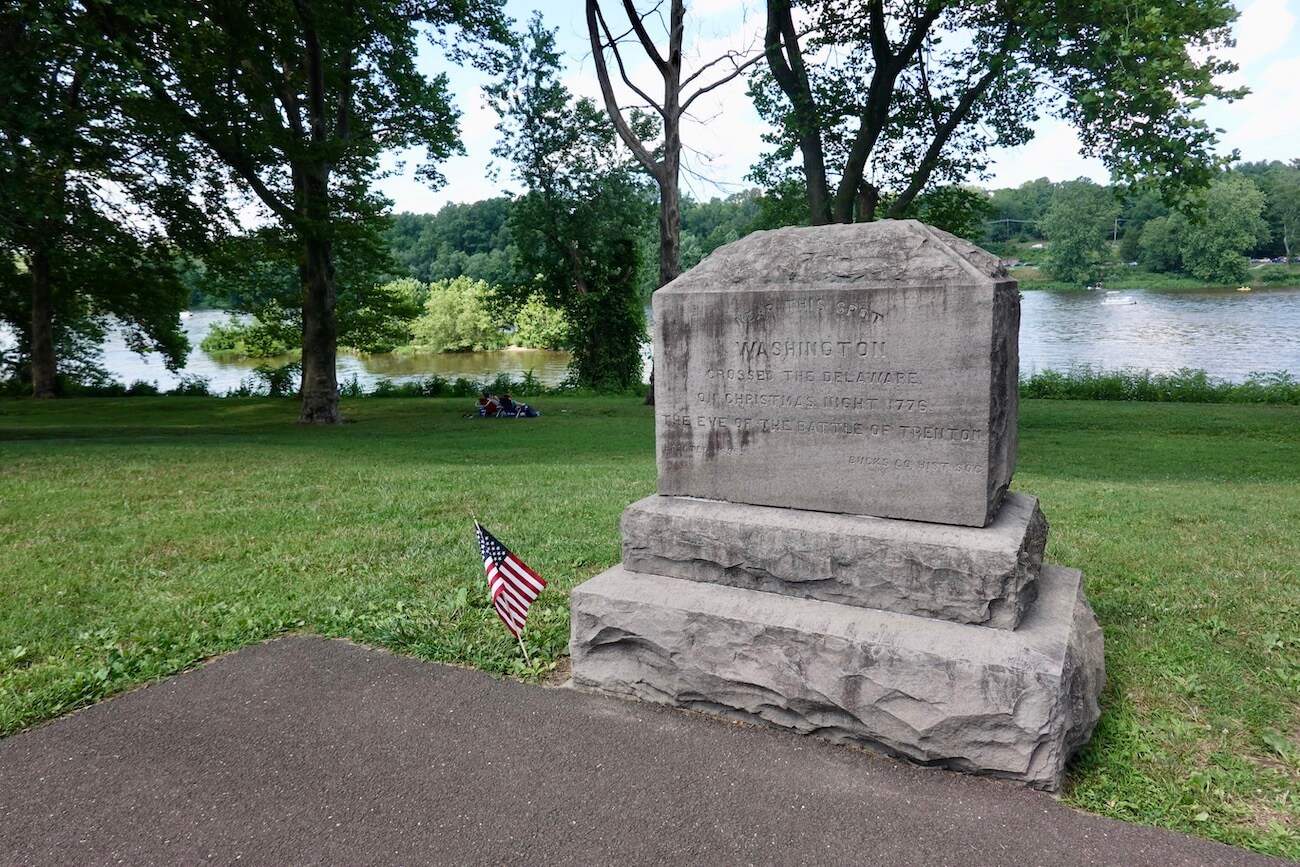
Planning a Surprise Attack
Washington was out of options, and the revolution was likely lost. Then came field intelligence that the Hessians (soldiers fighting for the British Army) were encamped in Trenton, just across the river and roughly nine miles south. The closest British encampment was in the Princeton area. A surprise attack and defeat of the Hessians before the end of the year would be a much-needed boost to troop morale prior to re-enlistment time. A victory would serve as a boost to the morale of the general public, as well. To help bolster troop morale before this daring attempt, Washington had the newly published pamphlet Common Sense by Thomas Paine read to the men. It originated the now-famous phrase, “Give me liberty or give me death.”
A Christmas Crossing
On Christmas evening, under the direct command of Washington, about 2,400 Americans, 18 cannons, and the required number of horses crossed the Delaware River. The river was on its way to freezing over during a vicious nor-easter storm (i.e., freezing rain, sleet, snow, and high winds). Due in part to the weather, the planned four-hour crossing took almost eight hours.
Once fully landed on the New Jersey side of the Delaware River, the troops marched south to the small hamlet of Trenton, where the Hessians were prepared for another day on their overseas combat assignment. (Many believe the Hessians were recovering from a Christmas celebration that included drinking and revelry. Historians say this was not the case. They were in a “hostile” land — far from home — and battle-ready all the time.)
The inclement weather helped disguise the now-delayed attack. Washington divided his troops and launched a coordinated attack from two sides (sometimes known as a “pincer” tactic). The battle was brief due, in large part, to the overwhelming number of cannons the Americans had coupled with the element of surprise. (The wet weather also limited the effective use of muskets.) The battle was short with the Americans decisively defeating the Hessians, taking over 900 Hessian prisoners of war. There were very light casualties on both sides. A few days later, Washington and his army went on to defeat a British contingent at Princeton before retiring his army to Morristown, New Jersey for the remainder of the winter.
Patriot Pride
The news of the small win in Trenton and the subsequent victory at Princeton spread quickly throughout the colonies. Public morale jumped — helped by the parading of the 900 Hessian prisoners of war through Philadelphia (the largest city in North America and home of the Continental Congress). This seemed to be dramatic evidence that Washington and the Continental Army could defeat the British Empire. There was hope. Their dream of independence could possibly become reality. The rest is history.
In closing, Washington’s crossing of the Delaware River is significant, and the resulting victory in the Battle of Trenton was a turning point in the Revolutionary War. As such, it is possibly the single most important event in the creation of the United States, next to the Declaration of Independence.
There are annual re-enactments of the river crossing in December (plus other programming throughout the year). Check on the park’s calendar of events for details.
Nearby Attractions
As a follow-up to spending time at this park, consider a visit across the river to Washington Crossing State Park in New Jersey. There you’ll learn about troop movements after the Continental Army reached that shore in December 1776.
Other great attractions in Pennsylvania are:
- Big Pocono State Park, Poconos
- Bushkill Falls, Poconos
- Colonial PA Plantation, outside Philadelphia
- Covered Bridges of Bucks County
- Covered Bridges of the Lehigh Valley
- Gettysburg Visitor Guide
- Hawk Mountain Sanctuary, Lehigh Valley
- Hickory Run State Park, Poconos
- Housenick Park, Lehigh Valley
- Jacobsburg State Park, Poconos area
- John Heinz National Wildlife Refuge, outside Philadelphia
- Museum of the American Revolution, Philadelphia
- National Museum of Industrial History, Lehigh Valley
- Philadelphia: Fairmount Park’s Unique Colonial Mansions & Their Stories
- Philadelphia Self-Guided Walking Tour
- Best Things to Do in Philadelphia
- Pittsburgh and Southwestern Pennsylvania Guide
- Promised Land State Park, Poconos
- Ricketts Glen State Park, Poconos
- Ridley Creek State Park, outside Philadelphia
- Tyler State Park, outside Philadelphia
- Valley Forge National Historical Park, outside Philadelphia
Final Thoughts
All the sites in this park are worthy of a visit. My favorite was the Thompson-Neely Farmstead and Grist Mill. It is during the guided visit of the Thompson-Neely House that you begin to imagine what life was like for this family when part of the Continental Army was living here. The soldiers were ill-clothed for the brutal winter weather — many without boots or shoes — and camped here for three weeks in December. Officers stayed in the home warmed by a fire. Soldiers were outside in the elements or in outbuildings. After touring the house, you get a first-hand look at the workings of a grist mill. All in all, it’s interesting to step back in time to imagine life here over two centuries ago.
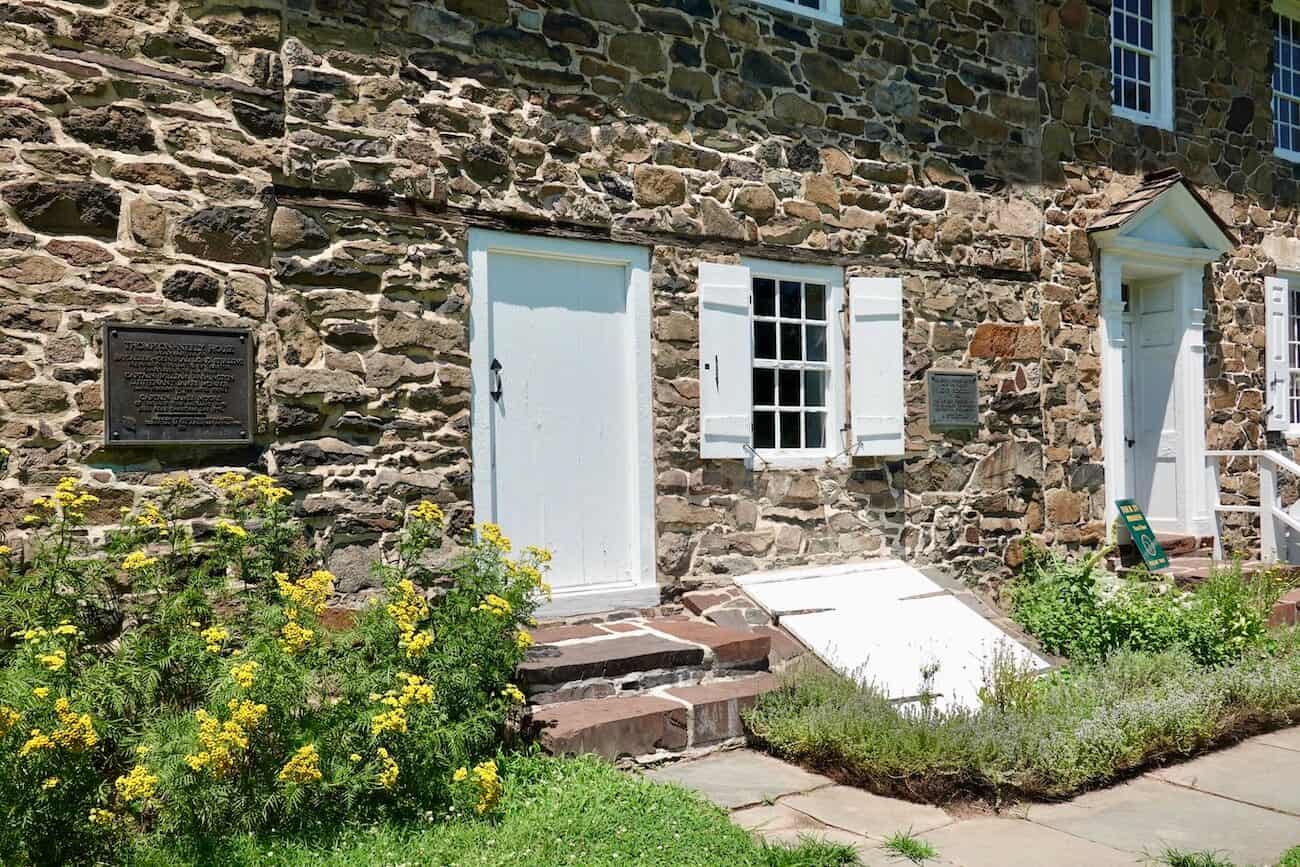
On the tour, you will likely ponder: What would you have done when a couple of hundred Continental Army troops came to your front door and wanted to camp out on your property for a few weeks? (Hint: If a Patriot, you were strongly encouraged to comply and give them access to all or most of your property — or leave for a period of time.) By the way, the army did not all encamp in the same area; instead, they were split up so as not to overtax any property owner. Having smaller groups also increased the likelihood that there would be an adequate supply of food for those on each property.
Bowman’s Tower is definitely worth some time (plan on spending 30 minutes here) to go to the top to enjoy the expansive views.
The visitor center is also interesting to visit to gain more background on the encampment in the area and the actual crossing of the Delaware River.
Pair History with Recreation
I highly recommend visiting Washington Crossing Historic Park in eastern Pennsylvania. While you’re in the area, consider spending time just relaxing with a walk or bike ride along the Delaware Canal State Park towpath that’s easily accessed from the Thompson-Neely Farmstead (Upper section of the park). Or bring a chair or blanket and relax on the sloping lawn behind the visitor center (Lower section of the park) to take in some relaxing river views. The entire experience — visiting the historic sites and enjoying some downtime here — makes for a wonderfully enjoyable day. Don’t forget to eat! There are picnic tables and scenic spots throughout the park to enjoy a picnic lunch from home.
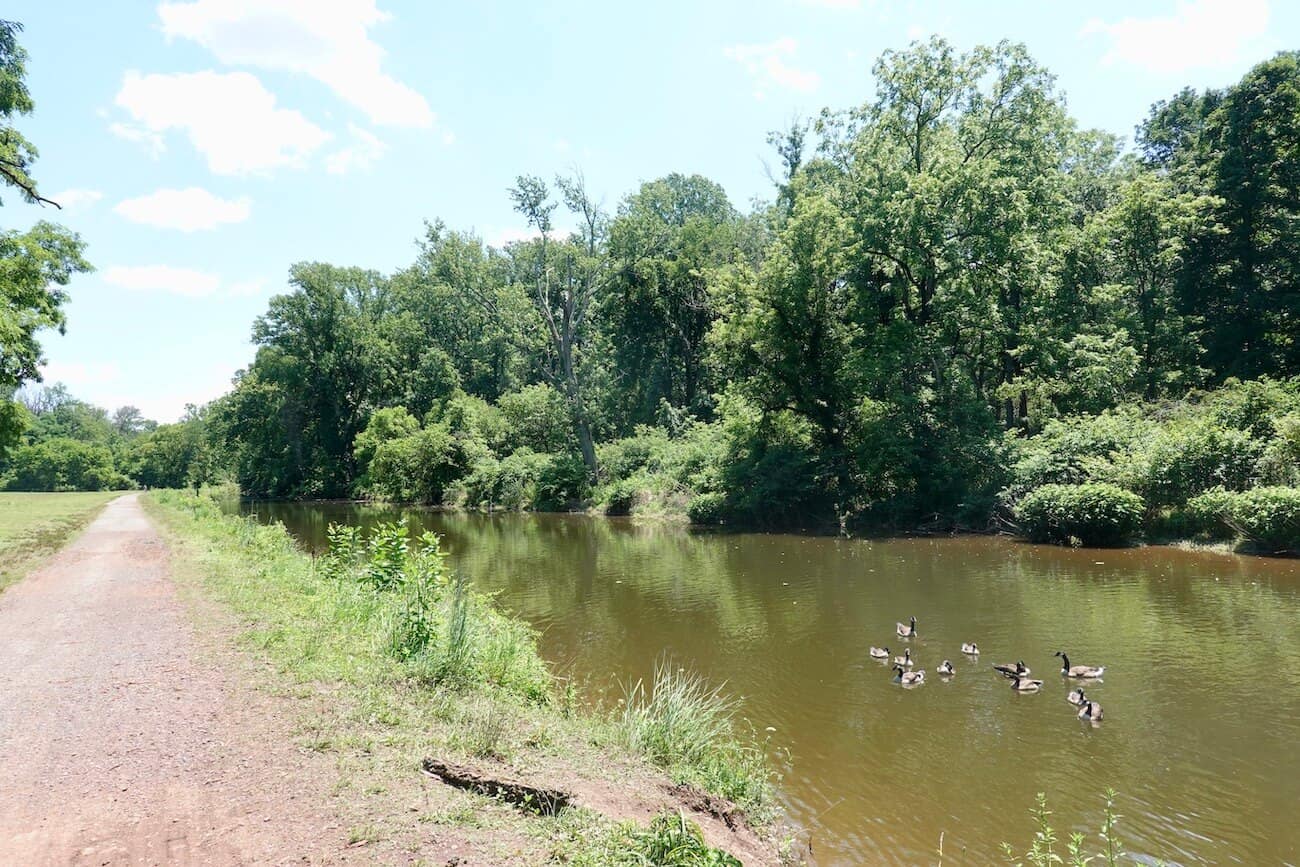
The park is 35 miles from Philadelphia, 45 miles from the Lehigh Valley, and 78 miles from NYC.
Comments?
Please share your experiences and/or suggestions for other places to visit in the general area. Your ideas could be helpful to other travelers. Thanks! 🙂

